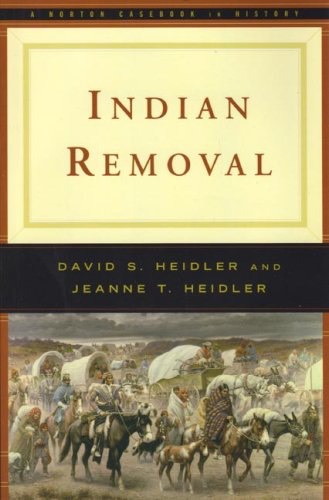Heidler and Heidler's Indian Removal is the first volume to appear in the new, innovative Norton Casebook Series. These books explore important topics in American history from the perspective of the participants. In Indian Removal, the Heidlers provide an historical survey of the origins of and rationale for the policy of relocating eastern Indians to lands west of the Mississippi. They trace the roots of that policy to evolving American attitudes about race and expansion. The transformation from the benignly conceived civilization program of the Washington administration to the blatantly self-interested plans for removal that were implemented by Andrew Jackson's administration is explained in detail. Rather than depicting this episode as a Manichean dichotomy of Good and Evil, the authors show how all sides were mixtures of benevolence and betrayal in a complicated series of events. Inescapable, however, is the basic fact that those Indians who trusted government promises, often inked into formal treaties and solemn agreements, were ultimately victimized by shameful duplicity and deliberate betrayal. Following this opening essay, the authors present excerpts from diaries, letters, and other primary documents with extensive exegeses to provide context and specific explanations about the course of white-Indian relations from the earliest years of the republic through the ordeal of removal and its aftermath.
From the W. W. Norton website:
Overview. This casebook traces the evolution of U.S. Indian policy from its British Colonial origins to the implementation of removal after 1830. Placing Indian removal in political and social contexts, the editors have selected contemporary primary-source documents that reveal the motives and perspectives of both whites and Indians and cover the complicated influences of Jacksonian Democracy and the early stirrings of what would later be called Manifest Destiny. Letters, treaties, and journal entries give readers a sense of the ordeal of removal for American Indians.
Excerpts
An Honorable Officer and the Cherokees
Brigadier General John E. Wool was dispatched to north Georgia in 1836 to facilitate voluntary Cherokee removal. Although he had two thousand soldiers under his command, he preferred to use persuasion to disarm the angry and friendly gestures to win over the reluctant. Despite Wool’s best efforts, many Cherokees remained unwilling emigrants. In 1837 with time running out, he delivered an impassioned appeal for compliance, and though his warnings must have sounded much like the menacing words Cherokees had endured from adversaries, Wool spoke them in friendship and out of deep concern for the Indians’ welfare.
. . . Wool eventually ran afoul of both state and national authorities for his treatment of the Cherokees. In the fall of 1836, he allowed a large meeting of almost three thousand Cherokees to meet and discuss freely the prospect of removal. When leaders such as John Ross were able to strengthen anti-removal sentiment, Wool was reprimanded by the War Department. His practice of sending rather than squelching Cherokee protests infuriated President Andrew Jackson, and the governors of Alabama and Georgia complained that he was too soft on Indians. Finally, he was replaced. Wool, however, saw no contradiction in being both a compassionate and an obedient officer, and he mounted a firm defense of his behavior as dictated by conscience, duty, and a code of honorable conduct.
From Indian Removal, A Norton Casebook (2006)
